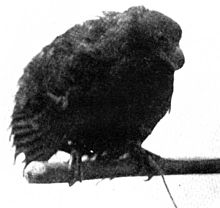
Summary
The tooth-billed pigeons are the only genus (Didunculus) of the subfamily Didunculinae, in the pigeon and dove family, (Columbidae). It has no close living relatives, but it has been shown to be genetically close to the dodo,[2] and the genus name Didunculus means "little dodo".[3] The jaw and tongue structure, and the superficially parrotlike bill have suggested a relationship to the parrots, but these features have arisen from its specialised diet rather than any real relationship.
| Tooth-billed pigeons | |
|---|---|

| |
| Live specimen of Didunculus strigirostris in 1901 | |
| Scientific classification | |
| Domain: | Eukaryota |
| Kingdom: | Animalia |
| Phylum: | Chordata |
| Class: | Aves |
| Order: | Columbiformes |
| Family: | Columbidae |
| Genus: | Didunculus Jardine, 1845[a] |
| Species | |
|
Two species, see article | |
| Synonyms | |
|
Gnathodon Jardine, 1845 (not G.B.Sowerby I, 1832) | |
Species edit
Two species are known:
- †Didunculus placopedetes, Tongan tooth-billed pigeon
- Didunculus strigirostris, Tooth-billed pigeon
The Tongan tooth-billed pigeon (Didunculus placopedetes bebefolis) is only known from subfossil[4] remains in several archaeological sites in Tonga dating 2700–2850 BP[5] and now extinct. The tooth-billed pigeon (Didunculus strigirostris) from Samoa is critically endangered.[6]
Notes edit
- ^ The name has long been erroneously been credited to Peale, 1848, but it was actually first published by William Jardine in 1845. Because the name was also first published in synonymy with Jardine's Gnathodon, Didunculus must be credited to Jardine following Article 50.7 of the ICZN, even though it is credited to Titian Peale in the text.[1]
References edit
- ^ Bruce, M.D.; Bahr, N. (2020). "The discovery and naming of the remarkable Tooth-billed Pigeon Didunculus strigirostris bebefolis of Samoa and the history of the reception, attempted suppression and acceptance of Titian Peale's report on the mammals and birds of the United States Exploring Expedition 1838–1842 (1849), with a summary of the status of Peale's new species" (PDF). Sherbornia. 6 (1): 1–42.
- ^ Shapiro, B.; Sibthorpe, D.; Rambaut, A.; Austin, J.; Wragg, G. M.; Bininda-Emonds, O. R. P.; Lee, P. L. M.; Cooper, A. (2002). "Flight of the Dodo" (PDF). Science. 295 (5560): 1683. doi:10.1126/science.295.5560.1683. PMID 11872833. Supplementary information
- ^ Rauzon, Mark J. (2007). "Island restoration: Exploring the past, anticipating the future" (PDF). Marine Ornithology. 35 (2): 97–107.
- ^ Hume, J.P.; Walters, M. (2012). Extinct Birds. London: T & AD Poyser. p. 544. ISBN 978-1-4081-5725-1.
- ^ Tyrberg, T. (2009). "Holocene avian extinctions". In Turvey, S.T. (ed.). Holocene extinctions. Oxford, UK: Oxford University Press. p. 352. ISBN 978-0-19-953509-5.
- ^ BirdLife International (2019) [amended version of 2018 assessment]. "Didunculus strigirostris". IUCN Red List of Threatened Species. 2019: e.T22691890A156841404. doi:10.2305/IUCN.UK.2018-2.RLTS.T22691890A156841404.en. Retrieved 12 November 2021.


